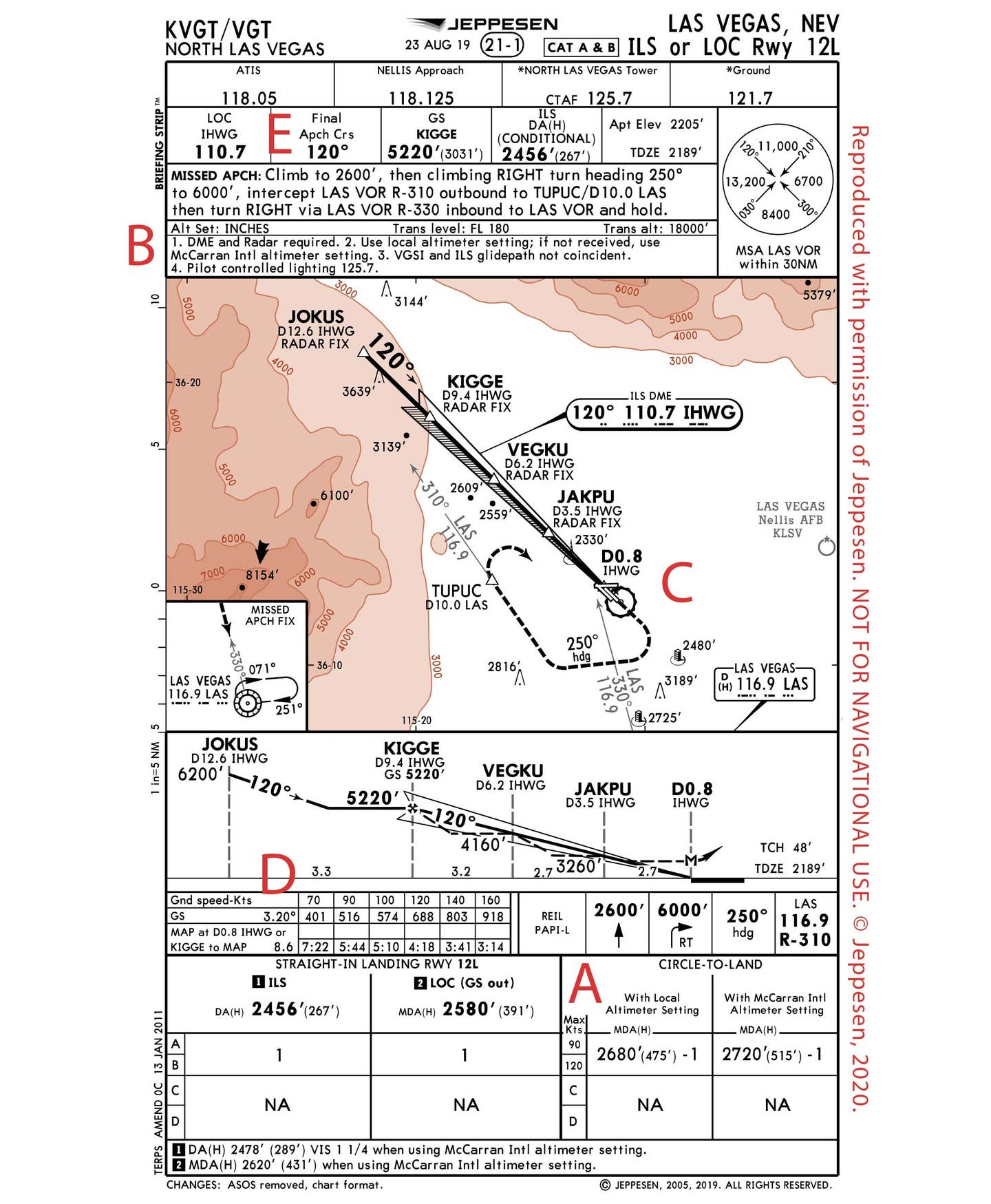
North Las Vegas ILS or LOC Runway 12L Courtesy Jeppesen
When pilots head to Las Vegas, most think of the nightlife or maybe gambling. With nearly year-round sunshine and often scorching temperatures, the last thing on their minds is probably the weather, despite Las Vegas' regular monsoon season that runs from mid-June through September. That’s the time of the year when Las Vegas receives most of its annual 4.5 inches of rain—and it’s also when a pilot’s IFR skills could be put to the test. That’s how we arrived at this month’s chart, the ILS Runway 12L at North Las Vegas Airport. Because of KVGT’s proximity to town—just 5 miles north of McCarran International—pilots might also find themselves flying this approach simply for sequencing.
A. Opposite-Direction Approach
In spite of the terrain-laden territory west and north of the airport where peaks rise to 6,000 feet msl, this approach is frequently used despite prevailing westerly winds. A pilot assigned the Runway 12L approach should be prepared to circle to Runway 30R or Runway 25. A straight-in to Runway 30R would bring traffic too close for ATC’s comfort at McCarran. Pilots should expect circling instructions from ATC. While left traffic is common at most airports, it probably wouldn’t work here if the aircraft requested landing on Runway 30R; it would force the aircraft to first cross Runway 30L’s extended centerline.
B. DME and Radar
Note 1 located below the communications box indicates that aircraft must be DME-equipped or a carry a substitutable IFR GPS system, and ATC radar services must be used. A pilot could not fly this procedure as a full approach in a nonradar environment because there is no published way to establish the aircraft onto the localizer. A note in the plan view also confirms the DME distance—IHWG—is generated on the ILS DME frequency, 110.7.
Check out more charts: Chart Wise
C. Approach to the Shorter Runway
A quick look at the airport diagram highlights an issue that’s not apparent from looking at the approach plate itself: This procedure actually points aircraft at the shortest of VGT’s runways, 12L/30R. Parallel Runway 12R/30L is 800 feet longer. This means the higher circling minimums—2,680 feet, placing the aircraft 224 feet higher—must be observed if the pilot wants to land straight in on Runway 12R or circle to land to the northwest.
D. Steeper-Than-Normal Glidepath
Note 3 details an important fact: The ILS glideslope and the visual glideslope don’t line up. When the aircraft breaks out, it may be lined up on the ILS but appear higher than the PAPI sitting just left of the runway. The pilot will also see a note in the approach speed and timing box labeled “GS 3.20 degrees,” pointing out that this approach includes a 3.2-degree glideslope. A typical slope is 3 degrees.
E. Read All the Missed-Approach Text
Many missed-approach procedures are understood by looking at the graphical detail. But it’s easy for a pilot to believe this procedure begins on the 330 Radial. The graphic on the chart reminds the pilot to reference the hold using the LAS VOR and the 251 Radial inbound. In case this isn’t quite confusing enough, this MA puts the aircraft over the top of McCarran, so ATC might just have a completely different plan in mind in the event of a pilot’s real-world missed approach.
This story appeared in the August 2020 issue of Flying Magazine

Sign-up for newsletters & special offers!
Get the latest FLYING stories & special offers delivered directly to your inbox






